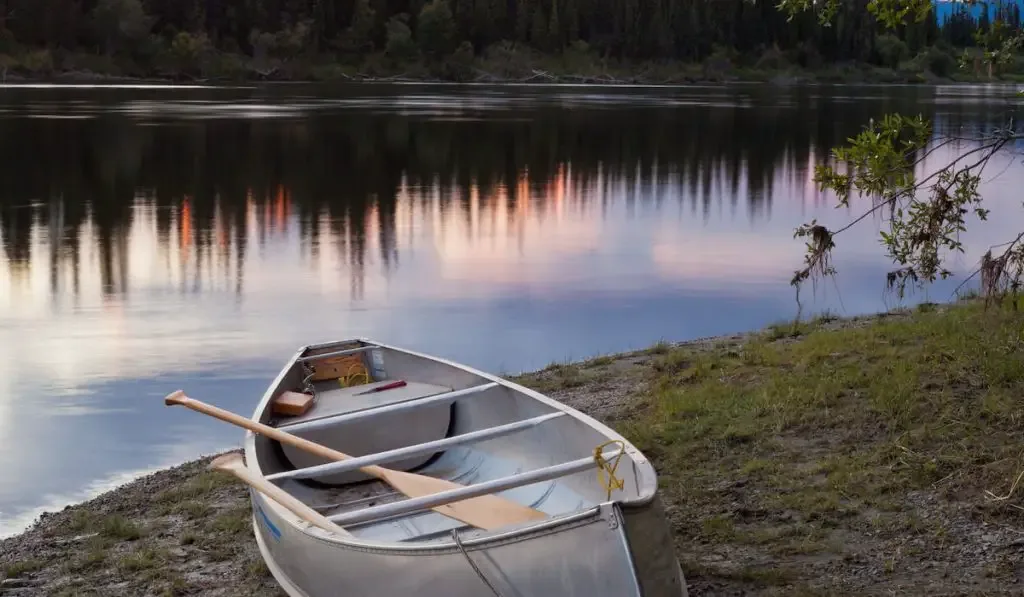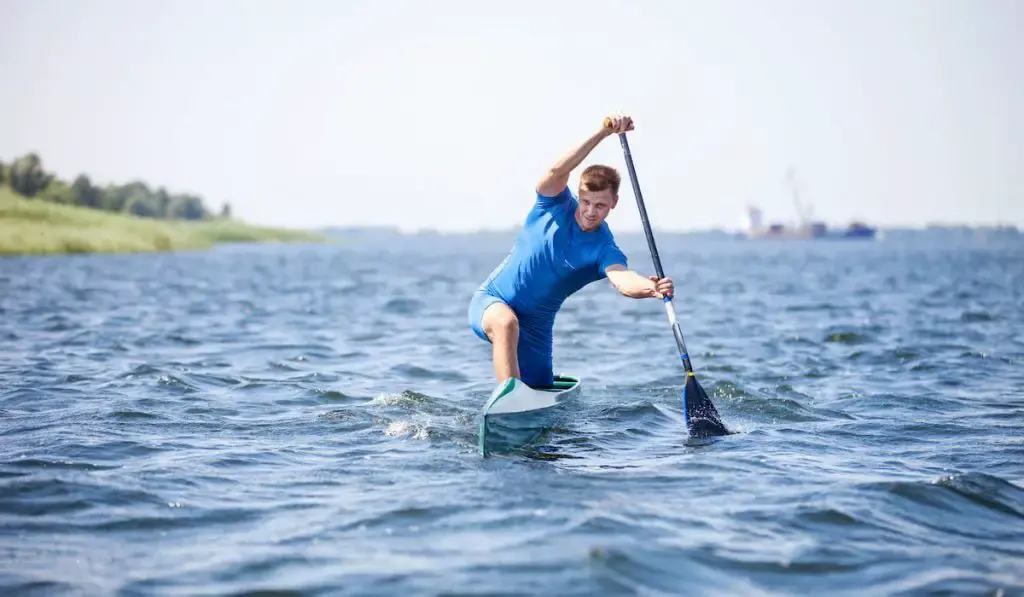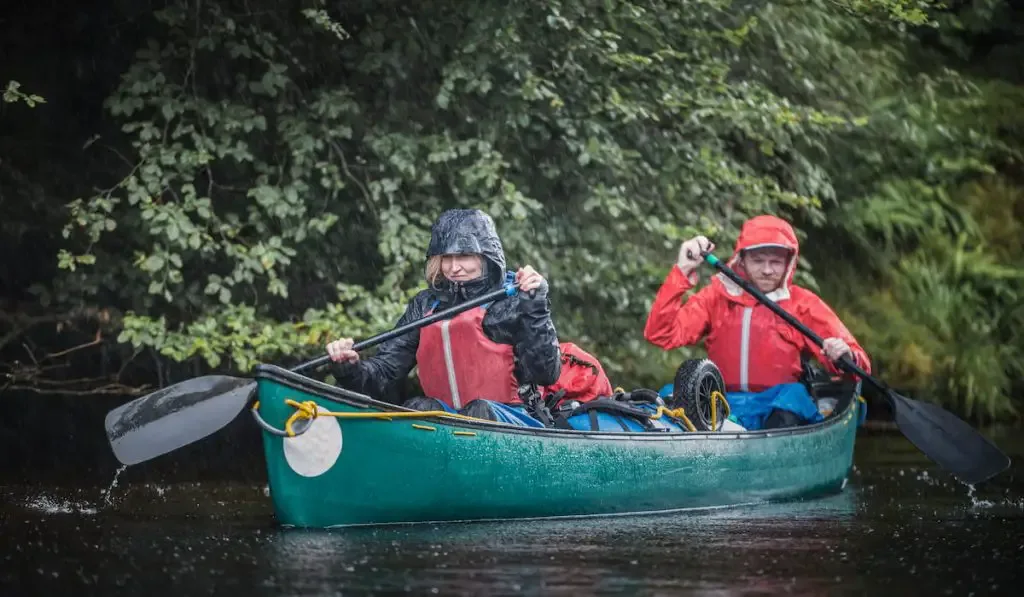No one goes sailing on the water looking to get in a boating accident. But with any type of boat, even canoes, sinking is always a potential hazard.
Can canoes sink?
Canoes, like every other watercraft, can sink. Canoes can take on water and go under when they are not used in the appropriate conditions.

For one, sailing a canoe in turbulent water or white water rivers for which it was not built puts the vessel at risk of sinking. Also, paddling canoes in harsh weather markedly increases the chances of going under. Fortunately, most canoes are naturally buoyant and will not be submerged completely.
In the later paragraphs, we go over some of the common reasons why canoes sink. We also talk about how you can prevent your canoe from going under. Then we look into canoe weight limits, what happens when a canoe gets filled with water, and much more.
Will a Canoe Sink if Filled With Water?
If your canoe takes on too much water, it will become submerged underneath the waterline. However, this does not necessarily mean your canoe will sink to the bottom of the lake or river. Your canoe sinking also depends on any modifications your canoe has.
Most canoes, especially those you can rent for recreational purposes or day trips, have floatation aids attached to them at the stern and bow. When these canoes get filled with water, they will not sink completely. As the name says, the floatation aids will keep them afloat to a degree.
Some canoes are sold with flotation aids already installed as standard. For instance, canoes made from aluminum usually come with floatation tanks that are similar to airbags.
While helpful to keeping vessels afloat, floatation tanks are not all perfect. If one of the tanks has a hole in it, the tank becomes useless, and your canoe will sink in an almost upright position. And if both tanks fail, the canoe will sink to the bottom.
Depending on the material it is made from, a canoe with no floatation aid attached may not sink completely.
For instance, boats made from Kevlar or marine plywood may not be submerged completely, with or without flotation aids.
However, when there is too much weight on your Kevlar canoe (equipment and gear), there is a higher chance of it sinking if it has no flotation aids attached.
Floatation aids offer buoyancy to canoes; they keep canoes from sinking to the bottom of the river.
In other words, floatation aids may not stop a canoe from going under. But they will prevent the vessel from being submerged underwater completely. This is possible because floatation aids provide enough buoyancy to keep the canoe afloat below the waterline.

What Can Sink a Canoe?
Anything that sinks a boat can also make a canoe go under. The following are some factors that can sink a canoe:
- Canoes are not built for turbulent waters, even when you fit them with outriggers for stability. If you use your canoe in rough white water, it may take on water and sink.
- Even with flotation aids attached, a canoe may sink in rivers filled with obstacles. You cannot use a canoe in the type of rapids drift boats, kayaks, and rafts run. However, if you take the risk of sailing your canoe in such places, you may not get your vessel back in one piece.
- Albeit not directly, a damaged floatation aid can sink a canoe. It is pretty simple: if your floatation airbag or tank is damaged, it will not prevent your canoe from going down. So, ensure you check your flotation aids regularly.
3 Reasons Why Canoes Sink
There are several reasons why watercraft like canoes, which are powered by people, sink. Most of these reasons are usually a result of human error. Here are 3 reasons why canoes go under:
User Error Can Sink a Canoe
People misuse canoes all the time, and of course, improper use of a canoe can cause it to sink. Errors that come from using canoes the incorrect way might cause the vessel to tip over. When this happens, the canoe will take on a lot of water before sinking.
To avoid sinking a canoe due to user error, you must know how to enter and exit a canoe. You must also know how to sit in a canoe correctly. The lower your body weight is to the bottom of the hull, the more stable it becomes.
Standing in a canoe raises your center of balance above the hull, making it unstable. So, try to remain as low as possible in a canoe to keep it stable.

Harsh Weather Conditions
Depending on how far out you are and the local weather conditions, the weather can quickly take a turn for the worse.
When the weather becomes torrential, navigation and maneuvering become almost impossible. Then the storm agitates the vessel, and if strong enough, tips the canoe over.
It is dangerous to take a canoe out on large water bodies like the coastal ocean regions or the Great Lakes without knowing the conditions you may face. Before you go canoeing, always check the weather conditions for that region.
You can get a GPS unit to alert you of any incoming inclement weather. You can also track the state of the atmosphere using your smartphone, provided you have a signal.
Remember to invest in a good waterproof bag for your smartphone. This way, you can rest assured that your phone will stay dry, especially when raining.
Over-Weighted Canoe Hull
Another mistake most people make is overloading their canoe. Like every other watercraft, buoyancy is what keeps a canoe afloat. But once you overload the canoe, buoyancy becomes ineffective, and the vessel will sink.
Before taking out your canoe, ensure it is not overweight. Know the limits of your canoe and stay within them. Even when the water looks calm, be cautious of your surroundings because things can change quickly out on the water.

How to Avoid Sinking a Canoe
Nothing is worse than planning a canoe trip and eventually sinking your canoe. Seeing all your gear and equipment sink can be quite painful. There is even the terrifying possibility of drowning.
Luckily, sinking is not a fate set in stone for canoes. With the following tips, you can avoid sinking a canoe:
Attach Floats or Airbags
There are several floatation devices available. These floats or airbags ensure your canoe does not sink even when it gets flipped over. Attaching stern and bow floats to your canoe is a good idea. Many Kevlar and fiberglass canoe manufacturers install float pockets to the stern and bow regions of the canoe.
Know the Weight Limit of Your Canoe
Every watercraft, like a canoe or a kayak, has a weight limit.
Canoes have weight restrictions, but if you do not know the weight limit of your vessel, you can calculate it. Simply multiply the length and width of the canoe, then divide by 18. The 18 in the formula represents the average body weight of a person divided by 10.
Canoes are available in a variety of sizes. The most common canoe sizes are from 10′ to 17′ in length. A 10′ canoe will accommodate two people and a small amount of equipment.
A 17′ canoe will usually accommodate three people and a decent amount of equipment. However, you can still determine the capacity of your canoe with the formula above since the width can vary.
Some other ways to avoid sinking a canoe include:
- Never take your canoe out at night.
- Never take your canoe out onto waters above your skill level.
- Always check the weather before you go out with your canoe.
- Ensure you always have the proper equipment, for example, bilge pail, life jacket, whistle, etc.
- Never enter or exit your canoe when you are on the water, except if you do so in the appropriate manner. It can be difficult to board or get off a canoe when you are alone. So, when you are canoeing alone, use extreme caution. It is best to have people go with you even if they are in separate canoes.

How to Make My Canoe Hold More Weight
The weight limit of your canoe depends on the length, width, manufacturer, and materials used to build the boat.
A recreational canoe with an average length of 16 feet can hold about 940 pounds. A 17-foot canoe can support over 1160 pounds, while a 14-foot canoe can hold about 700 pounds.
If you want your canoe to hold more weight, get one made from fiberglass, wood, or aluminum. Avoid canoes made from Kevlar, Tuff Stuff, and Royalex.
If you go with a fiberglass canoe, choose one made from different composites. Fiberglass composites are made from sturdy fibers strengthened with resins. Canoes made from this material usually support more weight.
Final Take
A canoe, like every other watercraft, can sink. However, most canoes are buoyant enough to remain afloat below the waterline. Your canoe’s buoyancy depends on the type of material it is made from: canoes made from heavier materials are generally less buoyant than lighter ones.
Attaching flotation aids to the stern and bow regions of your canoe can prevent it from sinking completely. But using your vessel correctly and under the right conditions will keep it from going under in the first place.
